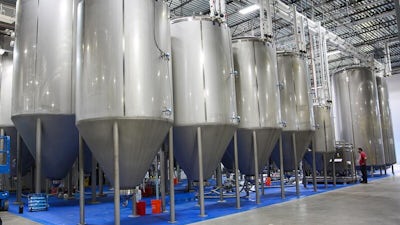Prevent Tank Implosion in Your Brewery During Caustic CIP
- Share on Facebook
- Share on LinkedIn
- Share on Email
-
Copy Link
-
Share Link
- Brewing
- October 18, 2019
- 5 Minute Read
- Share on Facebook
- Share on LinkedIn
- Share on Email
-
Copy Link
-
Share Link

Introduction
If one of your fermenters ever collapses due to vacuum failure, it will feel like the universe is caving in on you. That is why it is important to understand all the scenarios leading to vacuum failure and how to prevent them.
One common scenario is right after fermentation when your fermenter is filled with carbon dioxide. If you use caustic soda to clean your fermenter and do not have adequate vacuum relief, you risk imploding your tank.
Ashton Lewis, Master Brewer-in-Residence for Paul Mueller Company, demonstrates just how quickly vacuum failure can happen when you clean a fermenter full of carbon dioxide with caustic soda.
After Fermentation
During fermentation, yeast converts glucose into alcohol and carbon dioxide. After you transfer your fermented beer to a brite tank, you are left with a fermenter full of carbon dioxide.
Ashton uses an empty milk jug full of carbon dioxide to simulate a beer fermenter.
Clean-in-Place with Caustic Soda
To simulate cleaning in place, Ashton adds caustic soda to the jug and shakes it up. A chemical reaction between the CO2 and the caustic soda creates a vacuum within the container.
The jug is capped to represent a fermenter without the proper vacuum relief or a malfunctioning vacuum relief valve.
After only a short time, the jug begins to crumple from the lower pressure inside. As the pressure continues to drop, the weight of the atmosphere completely flattens the jug.
How to Prevent Vacuum Failure
To protect your tank from vacuum failure, you can open the racking valve while you CIP. It is also important to ensure your vacuum relief valve is large enough for your tank and working correctly. It doesn't matter how big of a vacuum relief valve you have if it is seized up from improper maintenance.
More from Mueller Academy
- Dealer Insights from Cornes AG
- Why Direct Load Milk Is on Its Way Out
- The European Union F-Gas Regulations & Their Impact on the Refrigeration Industry
- What is the HiPerForm® Refrigeration System?
- Introducing Our New Membrane-Based Water for Injection (WFI) Skids
- Manway Gasket Installation & Bushing Adjustment
- How to Decide Between a Horizontal & Vertical Milk Tank
- MES & PSG Feedwater Quality Requirements
- On-Site Tank Fabrication Under Deadline